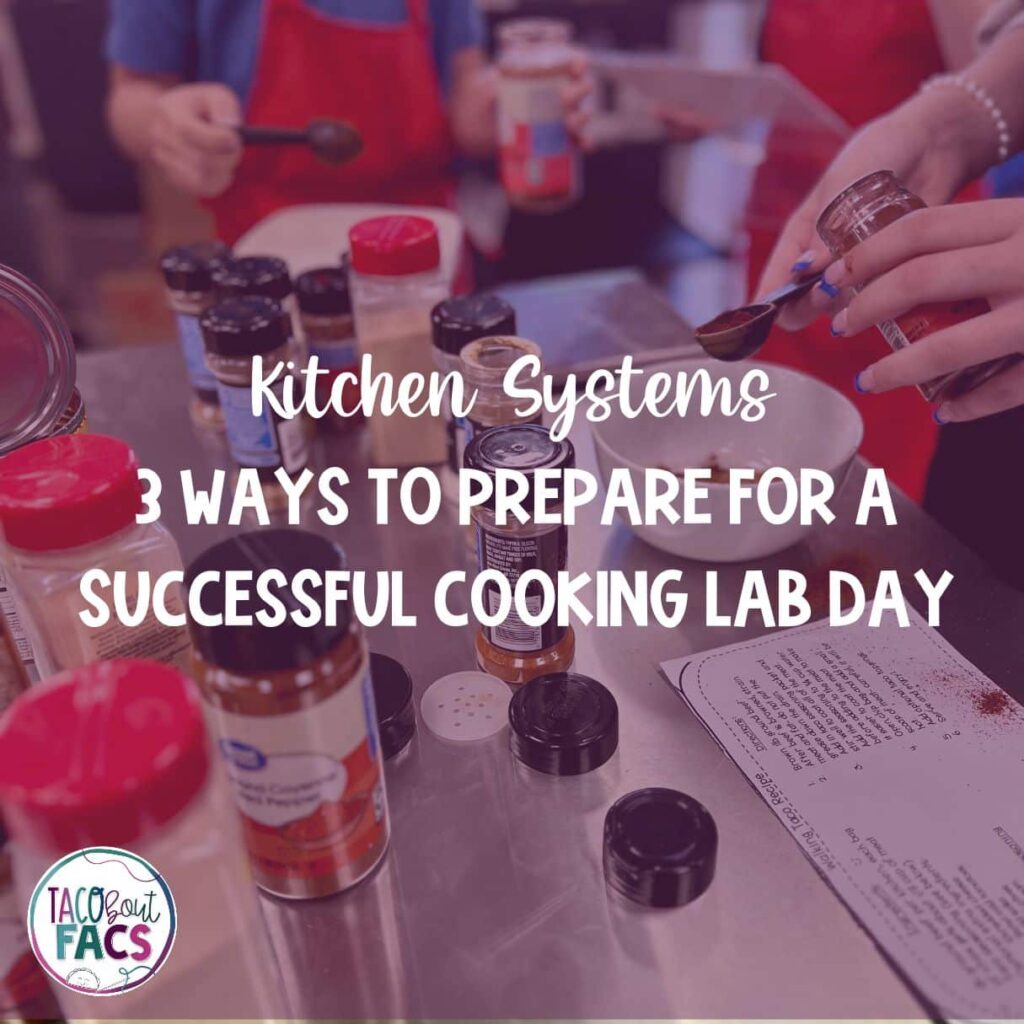Cooking lab days are another level when it comes to chaos, stress, and they can even be full of magical moments. Mastering kitchen systems and preparing students for successful cooking lab days can be attainable.
If you’ve spent any time in a FACS classroom during a cooking lab, you know how some groups bicker and argue. It also means there is likely someone standing to the side with crossed arms shooting eye daggers.
Other groups are working together as if it’s a perfectly planned cooking show and your teacher heart is bursting at the seams with how pleased you are in the moment.
Somewhere along the way, there is quite a bit of prep work that goes into a well-planned and nicely executed cooking lab day.
Check out the systems below to find ways to help your students sucessfully implement kitchen systems on cooking lab days. Setting up strong systems keeps you feeling organized and in control and helps your students properly prepare.
What are kitchen systems?
Kitchen systems are carefully organized routines and procedures you have taught your students BEFORE even going in the kitchen. So often students ask why they can’t “just cook”. I always remind them they can’t “just cook” because there are 30 kids in a class, some with and some without experience. In these groups, they need to understand how to work together.
Every semester I think I need more days before sending students into their first cooking lab. There are so many routines and procedures I want to cover before then cook, but then I am reminded some labs can happen earlier in the cooking season and some labs better fit after some trial and error in the kitchen and learning more routines.
For example, the fancy grilled cheese lab Is much easier to complete at the beginning of the cooking season. Students are still learning how to work together, time management, and moving around the kitchen.
Why are kitchen systems beneficial?
Preparing for kitchen systems before labs are beneficial for all students because of various levels of experience. In the middle school level, some students have never been cooking in a kitchen, let alone working with others in a kitchen.
You also get your expectations clearly laid out for students. They are left to guess how things should be done during lab days.
I am the first to step in to help wash dishes when absences leave a group down to two people, but I most certainly will not step in to wash dishes for a kitchen who didn’t use their lab plan day wisely.
My students know my expectations and when to ask for a tardy pass if time is running out. If I can see them working well together and they simply need more time, I will write a tardy pass. The group who didn’t know proper measurements, didn’t save yesterday’s recipe, is more focused on gossip than cooking, they know better than to ask for a tardy pass. It’s a natural consequence, but the system is clearly established before they are even in the kitchen.
Kitchen systems you might want to teach your students before cooking labs include:
Organizing your kitchens
Organizing the kitchen can be in colors, numbers, names, etc. While you might organize differently if you have an industrial kitchen setting, the residential kitchen set-up in middle school, might be best suited with colors or names.
This type of set-up allows students to learn the life skill and system of finding utensils and equipment, but also putting it away when cleaned and finished.
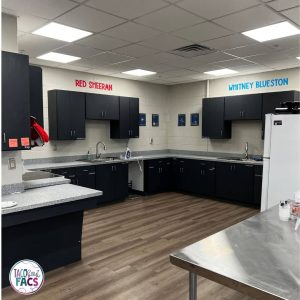
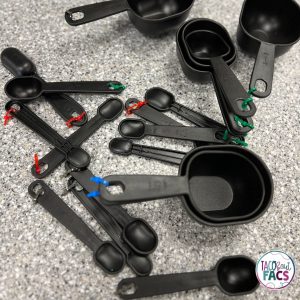
Kitchen cabinets are labeled, colored zip ties are used as much as possible, and each kitchen has their own set of equipment and tools. You can read more about it here.
Stuff still gets mixed up and doesn’t always make it back to where it should, but for the most part, students are able to stay organized in their kitchen.
Backwards time planning
Backwards time planning is essential. Students don’t have the best understanding of elapsed time- for those curious, I know I taught it in 4th grade math!
For example, if your class is 49 minutes, give approximate times for the various parts of the lab and subtract the time specific to that class.
It seems elementary, but I literally spell it out task by task.
- If the bell rings at 11:08 and you take 10-12 minutes to clean up for the first lab, you’d need to start cleaning by 10:56.
- If you get about 5 minutes to enjoy the food you prepared, you’d need to eat by 10:51.
- If it takes 3-5 minutes per omelet and you’re making 7 total, with two people cooking on both front burners, you would need to start cooking by 10:31.
- If it takes you 10-12 minutes to prep ingredients during the first lab because you’re still learning how things run, you’d need to start by 10:19.
- If it takes about 5 minutes to grab your hat, hairnet, or hair tie, put on an apron, and wash your hands….but really closer to 7 minutes because it’s your first time wearing a hairnet and you feel silly so you’re laughing too much to get started, you’d need to start by 10:12.
Even the most well laid out classroom systems need an extra minute or two on cookie lab day, but by this point in the cooking season, they understand the need to stay focused.
Kitchen jobs and food lab plans
Every lab includes the same kitchen jobs- executive chef, sous chef, general manager, and line cooks as needed to fill the rest of the roles for those in the kitchen.
The day before each lab, I show a short 5 minute video about the lab instead of me doing a demo. I chose this because there are always students absent and it allows them to watch it outside of class if they missed it. It’s also worked nicely because so many students will say they practiced the lab at home the night before.
After discussing why I chose the lab, the skills I am noticing, and the ingredients needed to complete the lab, students get in kitchen groups and choose their kitchen job while completing the food lab plan.
I prefer the role of executive chef be shared and not exclusive to one person, but I also don’t take the time to monitor that roles have not been repeated.
Food lab plans have students writing down the specific ingredients for the lab, writing the equipment and utensils needed, plus where they are located in their specific kitchen. On the back of the plan, they write out specific steps, even as simple as who is spraying the counters at the beginning, who is getting ingredients, etc.
While I am strict expecting the food lab plan and jobs be well-written the day before, I’m lenient if natural leaders step up and work together as needed during the actual lab.
I have a detailed rubric I use to document as needed during the lab and students reflect the day after the lab allowing them to “tattle and let it all out” if someone in their group wasn’t meeting their expectations.
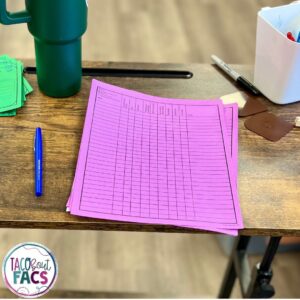
Side note: Using a rolling computer desk has been a great way for me to keep my supplies separate, but ready for labs. Students also know this is my “desk away from desk” on lab days. The top right container has tardy passes if needed. My rubric is always printed on purple paper to make it easy to find. Guest judge feedback is always printed on green paper so students and guest judges know to expect. You can’t see the blue basket at the bottom of the cart to collect food lab plans when they are finished with the lab.
If these resources are more specific and something you feel like your students might need, you can find these resources and a few more options in each of the cooking lab resources. It helps keeping the same routine for each cooking lab and students come to expect it and know the drill.
How can you better prepare for kitchen systems?
Plan out how you want your kitchen to run. If you’ve had kitchen labs, think about what drove you crazy, what you cannot deal with if it were to continue happening? Maybe that’s kitchens that aren’t quite clean or equipment put away.
Spend time going over those expectations. I have a page hanging in each kitchen about the steps to make sure a kitchen is cleaned properly. We cover during class before cooking. It’s hanging on the wall above each sink. It doesn’t mean they read it, but I can refer back to it.
I also make it relatable because I tell stories about what has happened in the kitchen. And I don’t mind telling students they too will become a story if needed.
Such as the new red signs on each microwave that say not to put metal in the microwave. On the last week of school, that group asked if they could throw away the signs. Nope, those served a purpose and will continue to serve a purpose.
For your kitchen systems to be most effective, you cannot assume students know your expectations. Be specific, think a couple steps ahead of everything they do in a lab.
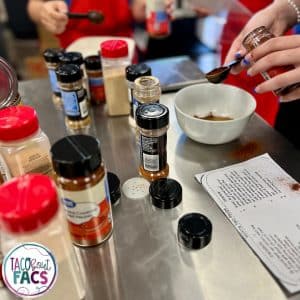
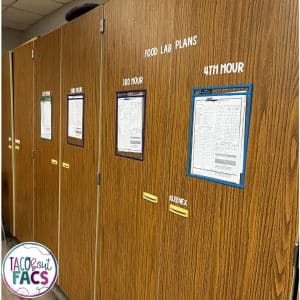
Know it is ok to implement new kitchen systems as you find a need. If it’s something to teach before all labs, make a note for next semester. If it’s something that needs to go into effect immediately, let them know.
And lastly, be consistent with your kitchen systems. You cannot explain it once and expect it to work seamlessly. There are some students who will carry out systems perfectly well. They are the rule followers.
Remind students before, during, and after labs. Stick firm to your expectations and routines. Students will follow. And surprisingly, students appreciate the routine and procedures.

